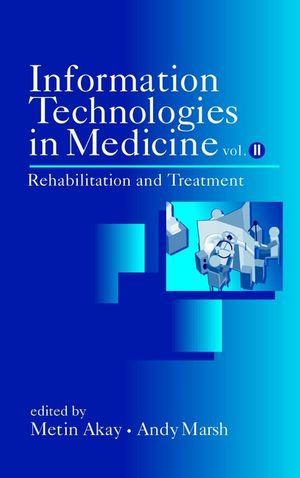Information Technologies in Medicine, Volume II: Rehabilitation and TreatmentISBN: 978-0-471-41492-6
Hardcover
216 pages
April 2001, Wiley-IEEE Press
 This is a Print-on-Demand title. It will be printed specifically to fill your order. Please allow an additional 10-15 days delivery time. The book is not returnable.
|
||||||
A comprehensive survey of technological developments in Virtual
Reality for use in a variety of medical procedures
Medicine and the biological sciences have long relied on visualizations to illustrate the relationship between anatomic structure and biologic function. The new multidimensional imaging modalities are powerful counterparts to traditional forms of observation-surgery, postmortem examination, or extensive mental reconstruction. VR technologies have reached unimagined levels of sophistication and utility, giving physicians and students new avenues for planning and practicing surgery and diagnostics.
The two volumes of Information Technologies in Medicine thoroughly explore the use of VR technology in three-dimensional visualization techniques, realistic surgical training prior to patient contact, and actual procedures in rehabilitation and treatment, including telemedicine and telesurgery. Editors Akay and Marsh have brought together all the available information on the subject of VR technologies in medicine and medical training to create the first comprehensive guide to the state of the art in medicine for use by students, doctors, and researchers.
Volume II concentrates on VR technologies specifically in the area of rehabilitation and treatment and provides complete coverage of the most recent advancements in high-tech medicine. Specific treatments include:
* VR in neuro/orthopedic rehabilitation
* VR in treatment of anxiety disorders
* Robot-assisted microsurgery
* VR and the vestibular system
* Maxillofacial virtual surgery
Medicine and the biological sciences have long relied on visualizations to illustrate the relationship between anatomic structure and biologic function. The new multidimensional imaging modalities are powerful counterparts to traditional forms of observation-surgery, postmortem examination, or extensive mental reconstruction. VR technologies have reached unimagined levels of sophistication and utility, giving physicians and students new avenues for planning and practicing surgery and diagnostics.
The two volumes of Information Technologies in Medicine thoroughly explore the use of VR technology in three-dimensional visualization techniques, realistic surgical training prior to patient contact, and actual procedures in rehabilitation and treatment, including telemedicine and telesurgery. Editors Akay and Marsh have brought together all the available information on the subject of VR technologies in medicine and medical training to create the first comprehensive guide to the state of the art in medicine for use by students, doctors, and researchers.
Volume II concentrates on VR technologies specifically in the area of rehabilitation and treatment and provides complete coverage of the most recent advancements in high-tech medicine. Specific treatments include:
* VR in neuro/orthopedic rehabilitation
* VR in treatment of anxiety disorders
* Robot-assisted microsurgery
* VR and the vestibular system
* Maxillofacial virtual surgery



